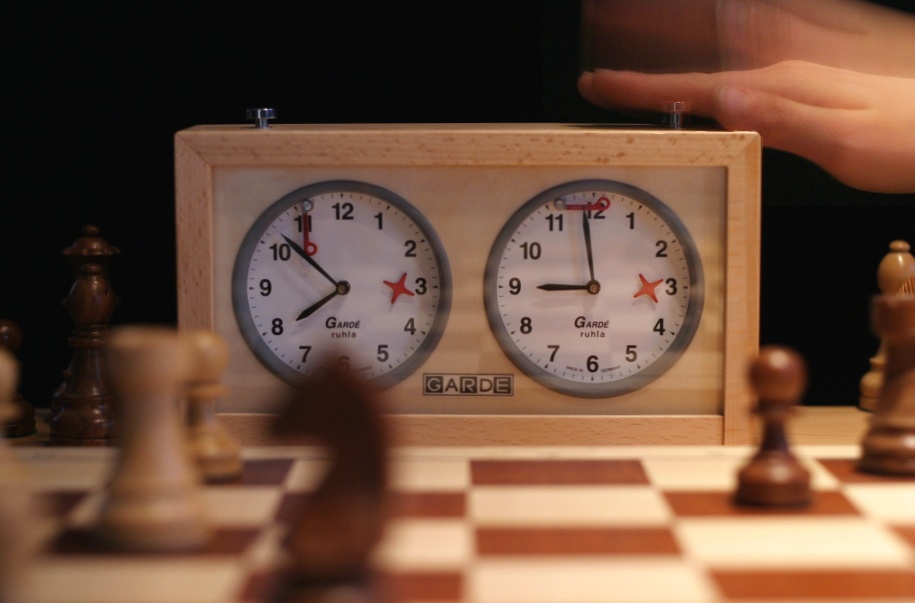
Featured Blog | This community-written post highlights the best of what the game industry has to offer. Read more like it on the Game Developer Blogs or learn how to Submit Your Own Blog Post
A different take on turn timers
Having a limited amount of real-life seconds to make a move can feel strangely disconnected from the rest of the gameplay experience. However, there's a different kind of timer out there. One that's intrinsic to the game world, or in short: diegetic.


Turn timers are a contentious topic. You generally don't have enough time to think on your turn, but your opponents on the other hand should ideally be acting instantly. And in single-player games you probably prefer to never be disturbed by a pesky timer at all, while thinking through all the possible options. The following text will try to shed light on the advantages of using timers, the good reasons to dislike them, and how they could potentially be saved in an alternate form.
Why have a timer?
If a game is supposed to be about intuitive decision-making, it not only has to hide some amount of information from its players, but also limit the time they have to make their decisions. Otherwise, they will simply go ahead and calculate the "correct solution". Or, in case this becomes an overly complex endeavor, they will cancel this process of calculation at an arbitrary point, thus limiting the resource called time, and thereby essentially making a design decision they shouldn't have to make.
Real-time games don't have this problem. The gameplay itself functions as an implicit, dynamic timer. Depending on the situation, players have more or less time available to make plans. In turn-based games however, the default is having a decision phase that lasts as long as you like, until you decide to explicitly end your turn. And limiting this time in a reasonable way can be quite tricky.
Timers as Extrinsic Limitations
Traditional timers ("You have 60 seconds to take your turn!") are generally abstract and hard to grasp elements of a game. The reason being that they're extrinsic to the game world, they're limitations imposed from "the outside". In the form of real-world time, real-world measures are applied and carried into the "magic circle" of the virtual world. This is not very intuitive, and it can also easily feel violently invasive. "Let me think for once!", you may think.

The "rope" announces the last 20 seconds of a turn in Hearthstone.
In multiplayer, timers are generally accepted, if often reluctantly as a kind of necessary evil. You don't want the other players to have to wait forever, after all. Single-player titles however can have a hard time justifying an explicit limitation of the player's thinking time:
"Having a mandatory timer on my turn is a real killjoy. I don’t play games like this to feel hurried." [Steam forum]
"Turn timers […] are a major no-no for me." [Steam review]
"I wanted to play against AI, but right after the first win it imposes a tight timer on turns, that is full BS. Uninstalling." [Steam review]
Minos Strategos and Wequer are two of the few single-player games that were brave enough to implement a turn timer. The above comments are examples of players' typical feedback regarding this design decision. And even if you're in the "pro timer" camp, they're understandable. When you're not even sharing the game world with other players, it's your very own magic circle that's being invaded.

Minos Strategos is one of the few single-player games to make use of a turn timer.
On the other hand, there is some appreciation for the inclusion of a timer, though it's much harder to find and rarely expressed as explicitly as in the following case:
"This is by far BrainGood’s best game, and I’m having a ton of fun. There is a lot to think about, and the addition of a timer helps with a lot of the action paralysis issues of their previous games." [Steam review]
Especially board gamers should indeed be able to find themselves in this statement. Board games generally don't come with a timer device and usually aren't played using one (apart from tournaments on the highest competitive level). Consequently, the so-called "analysis paralysis" is one of the most frequent problems gaming groups have to deal with.
Often this is framed as some kind of "disease": Some people just aren't able to make decisions in a reasonable amount of time! However, it's rather a failure of the system. It's the logical conclusion of never properly defining how much time to think is considered "okay". Each player has to find their own interpretation of this implicit social contract, which will inevitably result in an unfair distribution of the resource "thinking time". Typical consequences: social pressure ("Just do something, will ya?"), fighting, discontent. Where's your fun now?
The Alternative: Diegetic Timers
One way or another, timers would help. But it doesn't always have to be an in-your-face stopwatch. Timers that are intrinsic parts of the game world (in short: diegetic) feel much more natural. Players will in general have a much easier time accepting them, because they are simply "part of the game" and naturally integrated into the gameplay experience.
A great example of this approach is Crypt of the NecroDancer. In this game, the player and a bunch of monsters are "dancing" through a grid-based dungeon step by step. The timer in this case is the beat of the background music. Only actions triggered in time will actually be executed. If you hit a series of them, your score multiplier goes up. Miss a beat, and it resets. Players have much more leeway than in full-on rhythm games though. Because ultimately, it's not so much about testing their ability to keep in time, but about forcing them to make quick, intuitive decisions.
My own River Rogue is a game jam experiment specifically designed to illustrate the concept of diegetic timer. Again, the player moves discretely through a grid, essentially in a "turn-based" manner. The twist: The game world "flows" continuously towards the bottom of the screen and carries the player towards a "game over". This means the timer isn't auditory as in the case of NecroDancer, but visual and, even more importantly, spatial.
By choosing how far to move along the grid, the player interacts with the time they have available to think in the future. For example, rushing towards the top of the screen will grant you more time before you lose, but it comes with its own risks. Since moves are themselves a highly limited resource due to a stamina system, and you don't have any information yet on how the game world scrolling in from the top will be structured, choosing a far-ahead position too early can be quite suboptimal regarding your future path.
Now, the "real-time, turn-based" Nova-111 takes a different approach without a continuous meta-level timer. Instead, it uses a typical (unlimited) turn-based system and occasionally sprinkles real-time elements into it via in-world events. This regularly puts players up to time-sensitive challenges, such as having to avoid time-controlled bombs or falling stalactites.
Is this even turn-based?
By this point you may be thinking: Are those examples even turn-based games to begin with? The answer is: Not really, probably. But honestly, the categorization gets quite fuzzy once any kind of time limit enters the picture. You could even argue about an online card game such as Hearthstone with its maximum turn length of 75 real-life real-time seconds. But maybe this dispute is actually not all that relevant after all.
Whether they can formally be considered turn-based or not, all mentioned example games share one core strength: transparency. Their consistent and discrete interactions can be perceived, read and understood at a glance. In that way, players are able to come extraordinarily close to the underlying systems, the "heart of gameplay".
Diegetic timers allow for a design to hold on to this strength, without having to swing a stopwatch into players' faces, or making them take on the role of the game's designer to limit their potentially infinite turns themselves. This approach to turn timers holds a lot of potential and many uncharted game ideas. However, keep in mind that the design has to take this kind of timer into account from the very beginning. It can't just be tacked on after the fact. Once again, a holistic vision is key.
Read more about:
Featured BlogsAbout the Author(s)
You May Also Like







.jpeg?width=700&auto=webp&quality=80&disable=upscale)








